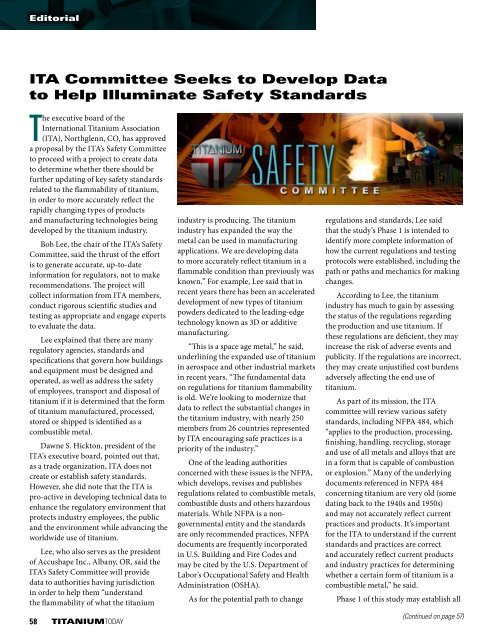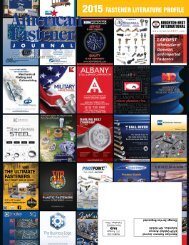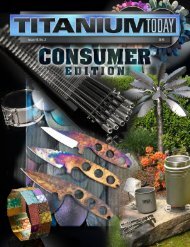100% Positive Material Identification
23mhiW2
23mhiW2
You also want an ePaper? Increase the reach of your titles
YUMPU automatically turns print PDFs into web optimized ePapers that Google loves.
Editorial<br />
ITA Committee Seeks to Develop Data<br />
to Help Illuminate Safety Standards<br />
The executive board of the<br />
International Titanium Association<br />
(ITA), Northglenn, CO, has approved<br />
a proposal by the ITA’s Safety Committee<br />
to proceed with a project to create data<br />
to determine whether there should be<br />
further updating of key safety standards<br />
related to the flammability of titanium,<br />
in order to more accurately reflect the<br />
rapidly changing types of products<br />
and manufacturing technologies being<br />
developed by the titanium industry.<br />
Bob Lee, the chair of the ITA’s Safety<br />
Committee, said the thrust of the effort<br />
is to generate accurate, up-to-date<br />
information for regulators, not to make<br />
recommendations. The project will<br />
collect information from ITA members,<br />
conduct rigorous scientific studies and<br />
testing as appropriate and engage experts<br />
to evaluate the data.<br />
Lee explained that there are many<br />
regulatory agencies, standards and<br />
specifications that govern how buildings<br />
and equipment must be designed and<br />
operated, as well as address the safety<br />
of employees, transport and disposal of<br />
titanium if it is determined that the form<br />
of titanium manufactured, processed,<br />
stored or shipped is identified as a<br />
combustible metal.<br />
Dawne S. Hickton, president of the<br />
ITA’s executive board, pointed out that,<br />
as a trade organization, ITA does not<br />
create or establish safety standards.<br />
However, she did note that the ITA is<br />
pro-active in developing technical data to<br />
enhance the regulatory environment that<br />
protects industry employees, the public<br />
and the environment while advancing the<br />
worldwide use of titanium.<br />
Lee, who also serves as the president<br />
of Accushape Inc., Albany, OR, said the<br />
ITA’s Safety Committee will provide<br />
data to authorities having jurisdiction<br />
in order to help them “understand<br />
the flammability of what the titanium<br />
58 TITANIUMTODAY<br />
industry is producing. The titanium<br />
industry has expanded the way the<br />
metal can be used in manufacturing<br />
applications. We are developing data<br />
to more accurately reflect titanium in a<br />
flammable condition than previously was<br />
known.” For example, Lee said that in<br />
recent years there has been an accelerated<br />
development of new types of titanium<br />
powders dedicated to the leading-edge<br />
technology known as 3D or additive<br />
manufacturing.<br />
“This is a space age metal,” he said,<br />
underlining the expanded use of titanium<br />
in aerospace and other industrial markets<br />
in recent years. “The fundamental data<br />
on regulations for titanium flammability<br />
is old. We’re looking to modernize that<br />
data to reflect the substantial changes in<br />
the titanium industry, with nearly 250<br />
members from 26 countries represented<br />
by ITA encouraging safe practices is a<br />
priority of the industry.”<br />
One of the leading authorities<br />
concerned with these issues is the NFPA,<br />
which develops, revises and publishes<br />
regulations related to combustible metals,<br />
combustible dusts and others hazardous<br />
materials. While NFPA is a nongovernmental<br />
entity and the standards<br />
are only recommended practices, NFPA<br />
documents are frequently incorporated<br />
in U.S. Building and Fire Codes and<br />
may be cited by the U.S. Department of<br />
Labor’s Occupational Safety and Health<br />
Administration (OSHA).<br />
As for the potential path to change<br />
regulations and standards, Lee said<br />
that the study’s Phase 1 is intended to<br />
identify more complete information of<br />
how the current regulations and testing<br />
protocols were established, including the<br />
path or paths and mechanics for making<br />
changes.<br />
According to Lee, the titanium<br />
industry has much to gain by assessing<br />
the status of the regulations regarding<br />
the production and use titanium. If<br />
these regulations are deficient, they may<br />
increase the risk of adverse events and<br />
publicity. If the regulations are incorrect,<br />
they may create unjustified cost burdens<br />
adversely affecting the end use of<br />
titanium.<br />
As part of its mission, the ITA<br />
committee will review various safety<br />
standards, including NFPA 484, which<br />
“applies to the production, processing,<br />
finishing, handling, recycling, storage<br />
and use of all metals and alloys that are<br />
in a form that is capable of combustion<br />
or explosion.” Many of the underlying<br />
documents referenced in NFPA 484<br />
concerning titanium are very old (some<br />
dating back to the 1940s and 1950s)<br />
and may not accurately reflect current<br />
practices and products. It’s important<br />
for the ITA to understand if the current<br />
standards and practices are correct<br />
and accurately reflect current products<br />
and industry practices for determining<br />
whether a certain form of titanium is a<br />
combustible metal,” he said.<br />
Phase 1 of this study may establish all<br />
(Continued on page 57)







